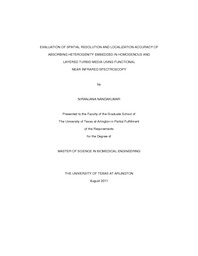
ATTENTION: The works hosted here are being migrated to a new repository that will consolidate resources, improve discoverability, and better show UTA's research impact on the global community. We will update authors as the migration progresses. Please see MavMatrix for more information.
Show simple item record
| dc.contributor.author | Nandakumar, Niranjana | en_US |
| dc.date.accessioned | 2011-10-11T20:49:17Z | |
| dc.date.available | 2011-10-11T20:49:17Z | |
| dc.date.issued | 2011-10-11 | |
| dc.date.submitted | January 2011 | en_US |
| dc.identifier.other | DISS-11327 | en_US |
| dc.identifier.uri | http://hdl.handle.net/10106/6202 | |
| dc.description.abstract | Functional Near-Infrared Spectroscopy (fNIRS) is a non-invasive widely used technique for imaging the brain activation patterns in the cerebral cortex of neonates and adults. For the fNIRS imaging of these brain activation patterns, it is common to assume the head geometry as a homogenous medium due to the resulting computational simplicity of the image reconstruction problem. In reality the head is not a simple homogenous medium and prior research has been conducted to show that light propagates differently in a spatially heterogeneous model of the head compared to a homogenous one, which alters the sensitivity of NIR light detection on the head's surface. However, the effect of heterogeneous background tissue optical properties on the reconstructed fNIRS images has not been systematically studied to date. In this work, a planar layered media approximation of the head was employed as a first step towards modeling the effect of spatially heterogeneous tissues on the reconstructed fNIRS images. The effect of neuronal activation on fNIRS measurements was simulated as in increase in absorption due to an increase in blood volume that occurred as a result of that activation. The increase in localized absorption relative to baseline values resulted in a decrease of measured NIR lightreflectance, as simulated by Monte Carlo. Subsequently, the diffusion approximation of NIR photon propagation in homogenous and layered was used in combination with a Tikhonov regularization procedure to reconstruct the simulated activation images. Spatial resolution, localization accuracy, and ovality metrics were quantified in the simulated fNIRS images. These virtual experiments were performed by placing a sub-resolution absorber of size 5 mm x 5 mm at three different locations within the field of view and by simulating fNIRS measurements for different source-detector geometries that ranged from sparse to very dense. Comparisons of reconstruction results and associated image metrics were performed between the layered head homogenous tissue models. It was found that the reconstructed images of the absorber for the homogenous and the layered medium were qualitatively similar. In addition, as it is not possible to know the exact optical properties of the brain tissues of each subject being imaged, the changes in spatial resolution and localization accuracy were assessed for variations in the background tissue transport scattering coefficient (µs') by ±50% and ±25%. The results showed that both the homogenous and the layered geometry are insensitive to incorrect knowledge of the background µs' values. It is concluded that spatial resolution and localization accuracy largely depend on the source-detector geometry when reconstructing fNIRS images in planar, laterally infinite, geometry tissues. | en_US |
| dc.description.sponsorship | Romero-Ortega, Mario | en_US |
| dc.language.iso | en | en_US |
| dc.publisher | Biomedical Engineering | en_US |
| dc.title | Evaluation Of Spatial Resolution And Localization Accuracy Of Absorbing Heterogenity Embedded In Homogenous And Layered Turbid Media Using Functional Near Infrared Spectroscopy | en_US |
| dc.type | M.S. | en_US |
| dc.contributor.committeeChair | Romero-Ortega, Mario | en_US |
| dc.degree.department | Biomedical Engineering | en_US |
| dc.degree.discipline | Biomedical Engineering | en_US |
| dc.degree.grantor | University of Texas at Arlington | en_US |
| dc.degree.level | masters | en_US |
| dc.degree.name | M.S. | en_US |
Files in this item
- Name:
- Nandakumar_uta_2502M_11327.pdf
- Size:
- 2.179Mb
- Format:
- PDF
This item appears in the following Collection(s)
Show simple item record


